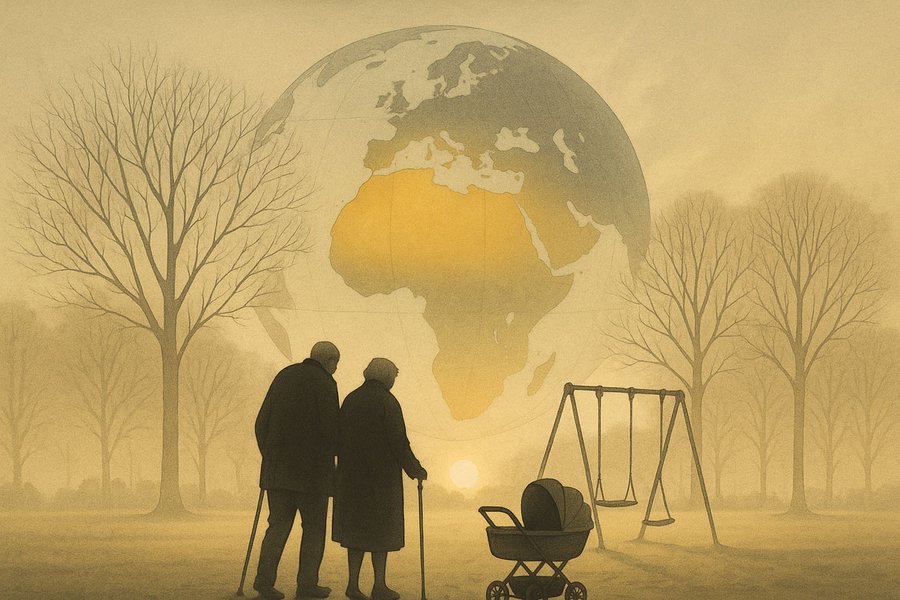Trump at 100 – So What? An Overview
By Major General Jonathan Shaw CB CBE
The conference aimed at assessing the impact Trump was having on the crucial global challenges discussed at our first conference 18 months ago: climate, demographics, technology and geopolitics.
Climate change is an inherited challenge that Trump will make worse, not just by his own ‘drill baby drill’ policies but by his soft power example; he has legitimised doing nothing about the growing challenge, with climate change indicators at record levels in 2023 and a perceived shift from predictable linear to uncontrollable feedback loop growth in threats (eg 28% drop in ocean CO2 absorption rates in 2024).
The global population, which has quadrupled over the last 100 years, looks set to top out at 10bn, with Africa having still rising populations and 30 of 31 top birth rates – in countries increasingly uninhabitable. Our UK obsession with small boats is a distraction from the real scale of the migration Europe is going to see as climate change hits. Trump’s impact on climate will thus be an accelerant on existing demographic and migratory trends, and his cuts to USAID will open the door still further to Chinese soft power.
US global dominance has been in decline from the unsustainable 1945 peak; Trump is fighting against this by shifting from supporting values to pursuing value – a realtorpolitik attitude. This threatens to abandon Ukraine and also potentially Europe where the end of the ‘peace dividend’ poses a huge challenge to western governments if NATO with an unreliable US is to have any credibility.
Technology has already encouraged populism amongst those disadvantaged by changes in manufacturing, but AI threatens to affect 85% of current employment with unforeseen political consequence. Trump’s alliance with the techbros means AI will be developed primarily for profit/value, not for the benefit of mankind. Indeed, techbros’ ideology sees technology being the replacement for a failed and outmoded democracy, with their near monopoly on sources of information making this threat all the more potent and hard to counter.
Trump’s influence overall is huge, and will endure beyond his tenure. Indeed, Trump is less a cause, more a symptom of change, driven by techbros, religious evangelicals and the Christian nationalists of the Heritage Foundation and Project 2025. These drivers will persist well after Trump has left the stage but are enforcing their will via executive orders (online for a record breaking 400 in the first year of his presidency?) in order to enshrine change before the status quo can mount resistance.

Trump 100 Days and Artificial Intelligence
By Dr Keith Dear
Artificial General Intelligence, one that out performs us in all cognitive tasks, or, put another way, one as smart or smarter than all humans that have ever lived, is not a sci-fi fantasy but rather a looming reality. If we reach it, it will be the most disruptive technology in human history. The current median estimate for when it arrives is 2026 (in a ‘weak’ form - still some limitations), 2028 as all-knowing ‘Oracle AGI’ and 2032 for ‘ASI’ - artificial super intelligence, one that outperforms humans in all tasks, including those needing dexterity, locomotion (walking/running), and proprioception (our sense of ourselves in time & space) - is 2032.
Trump is therefore likely to be the AGI President.
Three illustrations:
- Moore’s Law was 2x every 18 months / cost for a given level of intelligence falls 10x every 12 months
- Between GPT-2 (which you’ve never heard of - pre-Chat-GPT) and GPT-4 AI went from pre-school level to Post-Doc, in three years, a 200,000% increase in performance / between today and 2030, we expect a further 200,000% increase in performance, from Post-Doc to… ?.
- When ChatGPT came out (GPT-3) it could near-instantly complete coding tasks that took humans 30 seconds (2022)*, today it can compete tasks that take humans 1 hour / on trend, this would mean it could complete coding tasks that would take humans one month, and by the time Trump leaves office in 2029, it would be completing tasks taking 85, 24hr, days. Tasks that would take humans ~280 working days.
Hope is now the Strategy
- January, the US announces a private sector funded $500bn ‘Manhattan Project for AI’: Stargate. Caution on superintelligent models is gone.
- Under Trump, the AI & Crypto Tsar is David Sacks - he is South African, and a SpaceX, Tesla, Facebook and Anduril investor. Peter Theil is a long-time mentor to JD Vance. The PayPal mafia run much of US tech policy. Musk remains close (now left DOGE). ‘Move fast and break things’ Mark Zuckerberg competes for Trump’s attention.
- Trump supporter, Texan Senator Ted Cruz, calls the UK AI Safety Office ‘an Agent of Foreign Influence’.
- Discussion of the non-zero probability that AI kills us all is now undiscussable.
- At the Paris AI Conference in February JD Vance completely reframes the agenda of this conference series, which started at Bletchley Park to focus on protecting us from a misaligned AI, to call for hell-for-leather pursuit of ever smarter systems, an explicitly ‘America first’ agenda on tech where any regulation that affects its firms will be seen as an attack.
- There will be no planning to reduce the risk of AI doom (killing us all), nor of the potentially massive disruption if AI displaces or replaces many, potentially all, humans in the economy.
- Hope is now the strategy.
So What?
- If the US gets AGI and/or superintelligent models first, we may all be living under the US AI umbrella, a Faustian Bargain, whereby we trade agency for security, protected by a US whose diplomacy, military strategy, tactics, businesses and economic policy are literally all smarter than ours.
- There will be no plan to mitigate the security risks, the economic risks, or the existential risk from AI. Strangelovian logic now prevails. This is now a race where we could all lose, and yet must run.
*with >50% accuracy - the point is the rate of improvement primarily, but competence is rising at the same rate, this is just the benchmark used. In AI, after it is able to do things at a level better than chance, we have generally seen this be the beginning of exponential improvement.

Trump’s First Hundred Days: Geopolitics
By Michael David Shipster CMG OBE
Introduction
Things have already moved on from where we were on 30 April. These notes reflect the main themes that are now emerging, not just the short analysis presented a month ago.
From Day One Trump has:
- Been disruptive, sceptical of international rules-based order and traditional US ideology-led leadership of ‘The Free World’ which developed during the Cold War
- Adopted a transactional approach: tactical, nationalistic, focussed especially on securing economic advantage for the US, carving out scope to project power in pursuit of narrow US interests.
- Distrusted international organisations and alliances, multilateralism, charged that allies have been taking advantage of US generosity, especially in defence and trade.
What has Trump been right about?
- Equalising the NATO burden: need for allies to raise defence expenditure (well above 2%) and play a more active role in ensuring Europe’s security.
- Unfair Chinese trading practices, not playing by the rules, subsidies for Chinese exporters, manipulating currency exchange, exploiting US and western weaknesses and open markets to steal intellectual property
- International trade is unbalanced and unfair to US; trade policies need reform.
- Inward migration to the US was allowed to run out of control.
- US National Debt also out of control
- Too much regulation inhibiting US trade
- ‘Forever wars’ especially in the Middle East (Iraq, Afghanistan) should stop, as should promotion of western values (democracy) by force. US overseas interventions to promote nation building have served no useful purpose.
- Improving Israel’s relations with Middle Eastern neighbours (Abraham Accords) would improve global stability
- US should prioritise energy self-sufficiency, to keep prices down and reduce vulnerability to global shocks.
But:
- Speed of change and decision-making in Washington have created instability and uncertainty. Determination to enlarge executive powers through wide use of executive orders threatens US constitutional balance; faces challenges from judicial oversight (e.g. over tariffs), exacerbating uncertainty among trading partners.
- Alienation of allies and neighbours (NATO, unravelling of post-war international alliances), calling into question commitment to NATO Article 5 mutual defence
- Provocative bids for territorial aggrandisement: Greenland, Canada, Mexico, Panama
- Willingness to prioritise relations with e.g. Russia, allowing Putin to negotiate without needing to make concessions
- Reduced emphasis on US ‘soft power’ (radical cuts in international aid, downgrading of State Dept and conventional diplomacy)
- Reduced commitment to countering climate change
- Inconsistency and uncertainty, e.g. over tariffs, fuelling economic instability, rebounding on US economy
China
US now (cf Shangri La Dialogue) ramping up rhetoric on China; showing readiness to confront Chinese territorial and hegemonistic ambitions, trade practices, raising the stakes. Trump sensitive to accusations of negotiation weaknesses and readiness to back down. Potentially dangerous personalisation of bilateral international relations.
Russia-Ukraine
- Uncertainty over US threat to withdraw support for Ukraine (satellite intelligence, anti-aircraft weaponry, ammunition), to try to force Ukraine into an unfavourable settlement
- US ignoring wider long-term security threat that Russia poses to the Atlantic Alliance, bringing closer possibility of future military confrontation
- Reducing US commitment to measures to contain Russian threat, including cyber operations, sanctions, investigation of war crimes
How will the war in Ukraine end?
- No good or clear outcomes in sight. There are many players, high levels of uncertainty. Possible outcomes include:
- ‘Frozen conflict’, stalemate, unstable peace: likely in some form
- Russian military victory – still possible but not soon, depends on degree of European and US support for Ukraine
- Military victory for Ukraine - recovery of territory, reparations, punishment for war criminals, security guarantees (NATO membership) - unlikely
- Diplomatic settlement: unlikely for some years, many issues will remain unresolved, Scars of this conflict, akin to a bitter civil war, will take a generation or more to heal.
- Escalation: European or global conflict, possible but not imminent (most dangerous outcome)
- Putin overthrown or dies – no sign of either yet, but in any case Putin likely to be replaced by similar hardliner; Russian internal instability would carry dangers for international peace
- Instability in Ukraine leading to fragmentation; possible but unlikely as long as European allies stand firm
How should we (UK, Europe, other allies) respond to this uncertainty?
Do more to assure our own defence, reduce dependence on US
Keep faith with the international rules-based order: ‘A set of commitments by states to provide international governance that is not simply dictated by who is most powerful’
Trump and Trumpism are not a blip, are here to stay in one form or another. But clouds are gathering, opposition at home and abroad is growing including accusations of corruption, dynastic profiteering, illegal actions called out by the courts.
UK and allies need to stay calm, stick together, be patient, wait and see.
Most important security challenge: to craft a long-term response above all to deter aggression and to prevent wider conflict.
Conclusion
This is a dangerous period of international uncertainty and instability. Trump is not solely to blame but has been an accelerating catalyst. A long-term strategic readjustment is needed, but also wise, calm heads if we are to avoid damaging catastrophic confrontation between the major power blocs.

Trump 100 Days and the Middle East
By Nicholas Hopton
A summary of key points from an intervention by Nicholas Hopton at the MAST seminar on 30 April 2025
- What we know about Donald Trump‘s approach to the Middle East and North Africa from his first term as president:
- The Abraham accords were a singular US foreign policy success, particularly the impressive tech cooperation between Israel and the UAE.
- The blockade on Qatar proved a mistake and failure.
- The ‘maximum pressure’ policy on Iran failed to achieve its stated goal and made Iran a more dangerous actor in the region. Iranian enrichment has risen dramatically since the collapse of the JCPA triggered by US withdrawal, and there is no effective restraint mechanism on Iran developing a nuclear weapon.
- In Libya, White House mis-handling of communications with the warlord General Haftar in spring 2019 undermined fatally a UN-led national dialogue process and triggered an unnecessary and bloody civil war (2019 to 2020).
In his second term, President Trump has shown remarkable activism in the early phase. That led to a ceasefire between Israel and Hamas in Gaza coinciding with the new president’s inauguration. The White House also started direct negotiations with Iran for a new nuclear containment/sanctions easing agreement. The US bombed the Huthis in Yemen. And the US lifted sanctions on Syria and announced it would withdraw its troops. President Trump‘s visit to Saudi Arabia, the UAE and Qatar in May led to significant commercial and defence deals that should benefit the US economy.
At the same time, President Trump allowed the Israeli government to collapse the Gaza ceasefire and pursue an aggressive policy towards Palestinians that was condemned by the international community as disproportionate and failing to respect humanitarian obligations. In the negotiations with Iran, the US approach has appeared confused about whether the end goal is eradication or verification of Iran‘s civil nuclear capability. The US stopped its intense bombing campaign of Yemen claiming the Huthis had capitulated, though they continue to target Israel.
Taken in the round, President Trump‘s policy towards the Middle East in his second term seems tactical and lacking a strategic plan. Increased US engagement in the region has been undermined by mixed and confusing messaging, eg on Gaza and Iran. If Donald Trump is to achieve his stated personal objective of winning the Nobel peace prize, a more consistent approach and working more closely with allies to achieve good outcomes will be needed.

Demographic Winter: The Quiet Crisis Reshaping Our Future
By Robert Fox MBE OSI (Italia) MA
It is a truth scarcely universally acknowledged that the human race is ageing, and after climbing towards 2080, the numbers will be in decline by the end of the century. Behind this is the rapid decline in human fertility. The size of families across the world and almost without exception is getting smaller. Women are choosing to have children later, and in the developed countries fewer of them.
The phenomenon of ‘demographic winter’ or ‘demographic autumning’ – to give it a softer edge has been around for some time. Editorial desks, papers and newsrooms don’t like the expression – as it carries overtones of the toxicity of that old chestnut of white supremacists known as ‘the great white replacement conspiracy.’
We are in an era of great demographic shift, meaning societies are changing shape, especially with regard to the balance between the young and old, the productive and non-productive, the active and passive. These should be major considerations for policy makers and administrators, politicians and community leaders. The demography of Trump’s America will be very different in 2030, when in theory he should have left office, than in the 2024 when he was elected for his second term. The demographic shift affects the fundamentals of policy, wherever in the world – of welfare, health care, migration, security, resilience and defence – just to nominate the top items.
Some ten years ago humanity had its year of what Prof Francesco Billari of Boccone University Milan, calls ‘peak baby’, the year in which the most humans were born in history. He puts the year at 2012, though the latest reporting from the UN Population Division and the Lancet, the medical science journal, put the year at 2016, when 142 million young humans were born. By 2021 the number had dropped to 129 million.
Population projections by nation and country are even more startling. In the past year India has overtaken China as the most numerous country in the world. China, with something like 1.4 billion in its population at the beginning of 2025 is witnessing a trend of recording more deaths than births. By the turn of this century estimates suggest it will have a population of 800 million – some suggesting possibly as few as 600 million by the years 2110 CE. By then roughly half the world’s population will be in, or haling from, Africa.
In 2024 the global population reached 8.2 billion and seems set to rise for another sixty years. But then, somewhere between 2080 and the year 2083 it will peak at around 10.3 billion – and then decline. In 2100 the world population will drop to 10.1 billion and continue to fall.
“Accurate assessments of current and future fertility … are essential to help plan for the profound social, economic, environmental, and geopolitical challenges that these changes will bring,” the Lancet stated in a major article on demography in March 2024.
The measurement of fertility – the Total Fertility Rate, or TFR – suggests that women should bear an average of 2.1 children to maintain the future stability of a nation or community. The UN Department of Economic Social Affairs’ World Fertility 2024 Report showed the general decline in TFRs across the world. By the end of the 21st century it is likely, according to the UN that only six countries will be at the 2.1 TFR or above. They are mostly in Saharan and sub-Saharan Africa – being Niger, Chad, Samoa, Somalia, Tajikistan and Tonga.
India, the largest country, would be below the 2.1 threshold by 2100. The fall in China will be 1.1 – with some projections, from the UN, suggesting the population could be as low as 638 million by 2100 – under half the population of 1,4020 million in 2024. The USA is expected to grow steadily until early in the next century, peaking at 420 million.
In 2024 both Germany and Spain are estimated to have reached their maximum population at 84 million and 47 million. Italy is already in sharp decline. Russia is facing a steady decline from around 150 million in 1995 to 126 million in 2100. Ukraine is projected to go down from 51 million in 1995, ro 30 million in 2025 and around 15 million in 2100.
The UK and France are projected to grow through most of the 21st century but will then face decline. France will reach 68 million by 2098 and then decline. The UK population is expected to peak at 76 million in 2073. In 2024 the numbers of indigenous deaths exceeded the number of births – the increase in overall population made up by immigration, a net inflow in 2024 currently estimated at about 660,000.
The revelations of the two reports published by the UN in May 2025 on World Fertility and World Population caused a spasm of commentary in media – generating a sense of moral panic. BBC Radio 4 even devoted its main show devoted to public ethics, ‘the Moral Maze,’ to the issue.
It is surprising that more attention hasn’t been devoted to the effects of the ageing population on economic and social development in the UK, and in particular the provision of welfare and health services. An ageing population is less healthy and needs more specialised care for the elderly. There are also wider side effects with diminishing confidence in public well-being.
Demographic wintering means fewer in productive activity, working and earning, to support a growing economically inactive population – pensioners, the sick and very young. It was this prospect, allegedly, that was one of the factors behind Chancellor Angela Merkel’s decision to admit in 2015 around a million refugees from the wars and disruption in the Middle East.
Much of the UN’s population and fertility studies is focused on the developing world – especially the mitigation of disease, family hygiene and health, childcare and parenthood. By 2100 according to one projection, some 54% of all babies will be born in and around sub-Sahara and Equitorial Africa. By then Nigeria will the fourth largest nation at 477 million and the DRC (Congo) at 411 million. Lagos will top the table of large megalopolis cities at over 80 million, bigger than any European nation – while greater Tokyo will be a mere 30 million.
This is not just a game of numbers – and many of the numbers already mentioned in this article can and will be disputed; projections from bodies within the UN family, the World Bank, as well as Population Division of the UN, and the IMF vary by the millions, and even decades. One projection from the UN put the year of ‘peak baby’ as sometime around 1990 – though, admittedly, this is a startling outlier.
The changing of the shape of ageing societies like Japan, Italy, and UK even, is partly conditioned by a quiet revolution in attitudes, gender politics, family structures and mores. In Britain, Italy, Japan, South Korea women marry less, breed less, and those who do choose to have children later in life. A report in the Sunday Times of March 30th 2025 revealed that Bristol, one of the wealthiest cities in southern England, recorded a fall of 36 per cent in the birth rate between 2013 and 2023; a local TFR of 1.14. Six in ten of Bristol’s working age population have degrees, and of those women are in a slight majority. In Bristol the average age at which mothers gave birth is 33, and the UK national average is 31.
Women are, at last, taking a decisive role in business and the decisions of society. In Italy this has been stark – making it the fastest ageing of the European major economic powers. In Britain the number of octogenarians run to the millions. Currently the median age is 44 – in the US it is almost a decade lower at around 35 or 36 – and the US population is expected to reach its maximum somewhere in the decade of 2120 at around 421 million, which will put it in the top six most populous nations.
This does not appear to be a linear progress, however. Populations can fall quite suddenly, witness the story of South Korea where some communities seem on the point of collapse. In 2024 South Korea recorded a TFR of .8 % or even lower, and in Busan it has dropped to .3%. Young professional women interviewed by the New York Times bluntly stated they could not afford to raise a family, even of one child.
Attitudes to gender balance are changing, as a graphic cover story in the Economist of 5th June 2025 reveals. First the murder and abortion of infant daughters – once notable across Asia – is disappearing, though once it was a key element of China’s scandalous one child policy. Women are taking the initiative from Scandinavia to the Mediterranean – and in the EU community we now have powerful women slugging it out with their male counterparts, emblematic figures such as Von der Leyen, Kaja Kallas and Giorgia Meloni. As the Economist notes from Sweden to Italy it is the young to middle aged male tending to stay at home, and not the young women!
The demographic shift raises several issues and questions in politics and governance – which some administrations, in the UK especially, seem bent on avoiding. They issues range from care of the elderly and sick, resilience and public service, and the range of questions raised by migration and immigrant communities. A suitable guide to the discussion is the Sate Committee Demographic Developments 2050 commissioned by the Dutch government and published in 2024. It articulates in granular detail the problems raised by ageing in the Netherlands – the strains on infrastructure, and the need for continued, managed, immigration – a question on which the short-live Dutch coalition fell apart in May 2025 after barely six months in office.
Migrant labour will be needed, says the report in several key sectors – especially the lucrative agricultural, dairy, animal husbandry, meat and horticultural cut flowers industries. In the meat industry, for example, it has proved almost impossible to find native Dutch recruits for slaughterhouses.
One of the most powerful essays about the necessity and function of immigration into Europe, also comes from a Dutch pen – ‘How Migration Really Works’ by Hein de Haas,(Allen Lane and Penguin) currently of Amsterdam university, and formerly of the Institute for Migration at Oxford. He argues that economies like the US, UK, and Netherlands live by an open labour market. In the US and UK a large ‘illegal’, unregistered, working population, of at least 13 million in the case of the US, is vital to the economy.
In the UK, the prosperous southeast most markedly, the building and construction industry, as well as seasonal agriculture, would face collapse without the unregistered work force. The care sector, particularly care homes for the elderly, is dependent on foreign workers, usually paid exploitive low wages.
It is hard to see how the UK’s almost unique system of welfare and a health service based on the principle of free care at the point of delivery, the heart of the National Health Service concept, can survive as demographic winter looms. The NHS was launched in 1948, when the world population was hovering around 2.5 billion. Soon the UK will have a population of whom a half will be over 60, most of them retired.
Some have proposed that the smart use of AI and robotics could take up the heavy lifting and drudgery of care of the sick and elderly. The wish is father of the thought, and there is little evidence to back up the AI prophets. Human nature is a game of infinite and unpredictable variables.
It may be a surprise , then, that there is so little public policy enquiry and analysis given to the change in the demographic weather here in the UK. There is a change in the quality and quantity in the cohort of available recruits for the public and private sector – from cyber specialists and engineers, medicine and a whole range of public services, from the first responders to police and the armed forces. The whole issue of managing and motivating volunteers needs urgent overhaul as the debacle of managing volunteers in the Covid crisis illustrates.
The fit and capable elderly, over the current retirement age of 65, will have to be encouraged to continue work on a flexible basis. Equally, a system of smart immigration must be elaborated for public services.
Politically these matters are toxic – as is the whole topic of the ageing society. In the space of a month two crucial policy documents were issued by the Starmer Labour government at Westminster, the Defence Review – ‘once in a generation’ and the Comprehensive Spending Review, laying out the spending priorities to 2030. There is a ‘refreshed’ National Security Strategy to follow, a document cobbled together in a few weeks.
In the Defence and Spending Reviews, there was barely a mention of the changes in society now well under way – and they will be quite evident by the time both reviews come to be implemented fully, if they ever are. There was some low muttering about ‘health in an ageing society’ from the backbenches in some of the parliamentary debates, but nothing of consequence.
The Defence Review managed to give a broad-brush appraisal of what might be needed to protect the UK peoples at home and guard their interests abroad without any serious analysis of the changing nature of Britain’s society itself. It proposes increasing the numbers of volunteers, reservists, cadets by the thousand. Yet till recently more have been leaving the ranks than joining, and fewer are willing to join, despite rising population numbers, albeit driven by immigration.
Bunched together, the reluctance to serve, the anxiety factor about social and economic group participation and work, are symptoms of what we have to call demographic wintering. There can, and will be, means of mitigation, through greater community activity focus, professional and amateur, volunteer and part-time. Starting in the schools, who knows – we may be to spark up a bit of optimism and altruism? As Gisnrico Carofiglio, Italy’s top philosopher – thriller writer – mafia sleuth, puts it, altruism generally pays back in the end.
In the launch of the Defence Review, I asked several of the authors and creators, generals, defence secretaries, and senior officials, about what was their appraisal of the UK’s demographic shift in drawing up the future plan for defence and security of the country and its communities and forces? I explained the phenomenon of demographic winter. “What’s that?” said one of the politicians. “Never heard of it,” said a senior office holder.
They’d better get familiar with the concept. It may well bite them in their political prospects.






